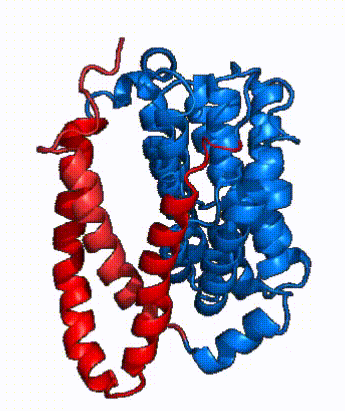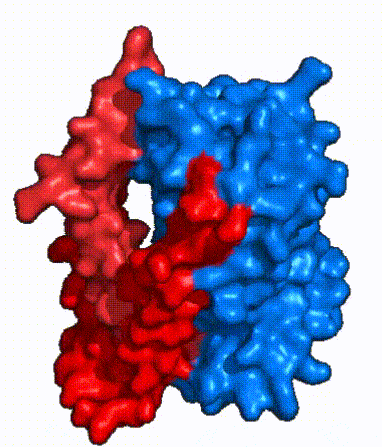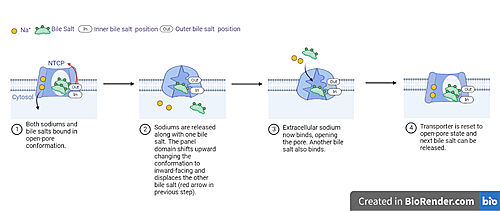Introduction

Fig. 1 Image of Taurocholic acid a crystalline bile acid
Sodium Taurocholate Co-Transporting Polypeptide, or NTCP, is a membrane transporter protein that is found in the plasma membrane of liver cells, or hepatocytes. NTCP's primary function is the transportation of taurocholates, or bile salts, (Fig. 1) into the liver and out of the liver to the small intestine. [1] Bile salts play various roles in metabolism and digestion, but their main function is the emulsification of lipid droplets into smaller fragments. This enables lipases to break down the droplets into their monomers, or triglycerides which are then able to be digested. NTCP is part of the solute carrier superfamily, more specifically SLC10. NTCP is the founding member of the SLC10 family, first discovered in rat hepatocytes in 1978. [2] NTCP has a key role in Enterohepatic circulation or bile salt recycling, and its unique ability to transport other solutes lends it therapeutic potential for lowering cholesterol and treating liver disease.
NTCP also serves as a binding site for hepatitis B virus and hepatitis D virus. [3] Future studies into HBV binding mechanism can help understand infection pathways and the development of viral inhibitors.
Structure
Binding Sites
Sodium
NTCP, like other SLC10 family members, have . Many polar and negatively charged residues (68, 105, 106, 119, 123, 257, 261) form ion-dipole or dipole-dipole interactions with the sodium ions in these sites with a high level of conservation, suggesting sodium binding is coupled to bile salt transport. [4] Mutations in the X-motif near sodium binding sites inhibit bile salt transport function, suggesting that sodium allows is required for salt binding.
[4] Thermodynamically favorable sodium transport facilitates changes in NTCP from open-pore to closed pore states, moving bile salts against their concentration gradient. The inward-facing state is favored in the absence of sodium ions, while open-pore state is favored in the presence of sodium ions. [4] This also allows for sodium concentrations to regulate uptake of taurocholates. When intracellular sodium levels are higher, open-pore state is favored allowing for the diffusion of taurocholates. However, when extracellular sodium levels are high, inward-facing state is favored preventing diffusion of taurocholates. [4]
Bile Salt
A key feature of NTCP is its which allows for bile salt transport across the hydrophilic membrane. The pore surface remains Hydrophobic, while the [INSERT GREEN LINK] lining of the open pore is largely Polar. In the inward-facing or closed-pore conformation, the polar pore residues are inaccessible. Only the surface hydrophobic residues are exposed. As the pore opens up, inner polar residues become accessible allowing for the binding of hydrophilic bile salts. The pattern of hydrophobic and polar residues within the pore matches the amphipathic patterns within taurocholate, steroids, and thyroid hormones. [5] Using this amphipathic pore, provides the channel with specificity while preventing leakage of other substrates. Essential form Van der Waals interactions with bile salt substrates, while others will form dipole-dipole or ionic interactions. The core domain contributes most of the polar domains, while the panel domain contributes mainly hydrophobic surface.
Conformational Change

| 
|
| Fig. 3 NTCP shown as cartoons with panel (red) and core (blue) domains colored. Helices are moving from open-pore to inward-facing conformation (7PQQ to 7PQG)
| Fig. 4 NTCP surface representation with panel (red) and core (blue) domains colored. Domains are moving from open-pore to inward-facing conformation (7PQQ to 7PQG)
|
NTCP utilizes an elevator-alternating mechanism [6] where one domain (core) does most of the translocation, and the other domain (panel) remains stationary. [7]. Only one taurocholate is transported at a time due to NTCP's two bile salt binding sites. An inner bile salt that is closer to the cytoplasmic side of the membrane and an outer bile salt that is closer to the extracellular side of the membrane [8] In the opne-pore stat both then both sodium ions are released into the cytoplasm along with the inner bile salt into the cytoplasm (Fig. 5). The in the pore, likely helping to prevent leakage. [8] The into the inner bile salt binding site by the movement of sodium ions, this displacement then facilitates the conformational change to the inward-facing, pore inaccessible conformation (Fig. 5). [8] Structure of the bile acid transporter and HBV receptor NTCP. Nature 606, 1021–1026 (2022). https://doi.org/10.1038/s41586-022-04845-4 </ref> Sodium ions then bind to NTCP, favoring the open-pore state and also allowing for the binding of another outer bile salt (Fig 5). The and the process can then start again releasing the next inner bile salt with the translocation of the sodium ions into the cytoplasm.
HBV Binding and Infection
NTCP is the only entry receptor [9] into the liver for HBV. [7] The myristolated PreS1 domain of HBV binds to NTCP through a containing residues 157-165 on the open pore surface. [7] These residues form part of the tunnel resulting in HBV binding and bile salt transport directly competing and interfering with one another. [7] Another consisting of residues 84-87 found on the N-terminus of NTCP does not overlap with bile salt binding and may be used for the development of antivirals that don't inhibit bile uptake [3]. Other minor variations within NTCP provide species specificity for HBV or virus resistance, such as mutant S267F found in East Asia. [3]
The exact mechanism by which NTCP mediates viral internalization is still yet to be determined; however, current studies speculate it works through endocytosis. [10] Once HBV is bound the NTCP/HBV complex is taken into the cell where viral contents are dumped into the cytoplasm to then begin viral replication. It is currently unknown whether HBV also interacts with other receptors or host cell factors, but NTCP alone is not sufficient for infection. [10]




